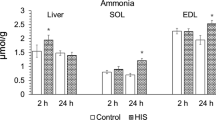Abstract
The mechanism of acute toxicity of TRIS-buffer was investigated in pentobarbital-anaesthetized Wistar-rats. An infusion of 0.5 mmol/kg · min TRIS, either pH 10.9 or pH 7.4, was tolerated for 60–70 min before death. TRIS concentration in plasma increased linearly to 53.7±9.09 mmol/l after 60 min (¯x±sx), indicating slow uptake of the drug into tissues. Blood pressure, heart rate, ECG and Na+- and K+-concentrations in plasma and erythrocytes were not influenced by TRIS. A small rise of plasma osmolarity by 39±4.7 mosmol/l after 30 min seemed unimportant for toxicity. With alkaline TRIS a metabolic alkalosis developed and the compensatory arrest of ventilation caused a sudden drop of arterial pO2 to 48±9 mm Hg after 50 min. A similar, though more gradual, decline of pO2 was observed with neutralized TRIS without concomitant changes of acid-base status. Artificially ventilated rats, with constant arterial pO2, tolerated an infusion of neutralized TRIS for at least 90 min. With TRIS of either pH plasma glucose concentration was nearly halved after 30 min. Addition of glucose (50 mg/ml) to the infusion neither prevented this effect nor increased the survival time. From these results we conclude that the main lethal action of TRIS is a depression of ventilation that, in the case of neutralized TRIS, may be related to an intracellular alkalosis.
Similar content being viewed by others
References
Bennett TE, Tarail R (1961) The hypoglycemic activity of 2-amino-2-hydroxymethyl-1,3-propanediol. Ann NY Acad Sci 92: 651–662
Bermann LB, O'Connor TF, Nahas GG, Luchsinger PC (1959) The renal effects of THAM in man. Physiologist 2: 3, 10 (Abst.)
Brasch H, Iven H (1981) Pharmacokinetics of TRIS (hydroxymethyl)-aminomethane in the rabbit. Arch Int Pharmacodyn 254: 4–12
Brasch H, Thies E, Iven H (1982) Pharmacokinetics of TRIS (hydroxymethyl)-aminomethane in healthy persons and in patients with metabolic acidosis. Eur J Clin Pharmacol 22: 257–264
Brown ES, Bennet TE, Bunell IL, Elam JO, Evers JL, Greene DG, Danney CD, Lowe HJ, Nahas GG, Tarail R (1959) Effects of THAM during CO2 breathing in man: ventilation and CO2 exchange. Physiologist 2: 18
Brown ES, Greene DG, Elam JO, Evers JL, Bunell IL, Lowe HJ (1961) Effects of 2-amino-2-hydroxymethyl-1,3-propanediol on CO2 elimination and production in normal man. Ann NY Acad Sci 92: 508–520
Burchardi H, Lawin P (1966) Die Behandlung der Störungen des Säure-Basen-Haushalts. Z Prakt An u W 1: 186–192
Buse MG, Buse J (1962) The effect of TRIS (hydroxymethyl)aminomethane on glucose utilization of muscle. Clin Res 10: 223
Coldman MF, Good W (1967) The distribution of sodium, potassium and glucose in the blood of some mammals. Comp Biochem Physiol 21: 201–206
Comroe JH jr (1964) The peripheral chemoreceptors. In: Fenn WO, Rahn H (eds) Handbook of Physiology, Section 3: Respiration, vol I. Waverly Press, Baltimore, pp 557–583
Epstein RM, Nahas GG, Mark LC (1961) Circulatory changes following rapid correction of severe hypercapnic acidosis by 2-amino-2-hydroxymethyl-1,3-propanediol. Ann NY Acad Sci 92: 500–507
Frölke W, Guénard J, Knappen F, Weisse I, Köllmer H, Stötzer H (1974) Blutwerte der Ratte in Abhängigkeit von Alter und Geschlecht. Arzneimittel Forsch 24: 1262–1266
Holmdahl MH, Nahas GG (1962) Volume of distribution of C14 labeled tris (hydroxymethyl) aminomethane. Am J Physiol 202: 1011–1014
Katz RL, Ngai SH (1962) Personal communication. Zit. in: Nahas GG The pharmacology of TRIS (hydroxymethyl) aminomethane (THAM). Pharmacol Rev 14: 447–472
Kellogg RH (1964) Central chemical regulation of respiration In: Fenn WO, Rahn M (eds) Handbook of Physiology, Section 3: Respiration, vol I, Waverly Press, Baltimore, pp 507–534
Müller-Plathe O (1968) Die Behandlung der metabolischen Acidose. Dtsch Med Wschr 92: 1661–1663
Nahas GG, Lumpkin WL (1959) The effects of THAM on the ventilation of the resting dog. Physiologist 2: 3, 87
Nahas GG, Jordan EC, Ligou JC (1959) The effects of a carbon dioxide buffer on the hypercapnia of apneic oxygenation. Am J Physiol 197: 1308–1316
Nahas GG, Teneick RE, Ploski WS (1962) Effects of organic and inorganic buffers on ventilation. Int Cong Physiol, zit. In: Nahas GG (1962) The pharmacology of TRIS (hydroxymethyl) aminomethane (THAM). Pharmacol Rev 14: 447–472
Ngai SH, Katz RL, Nahas GG, Wang SC (1961) Effects of 2-amino-2-hydroxymethyl-1,3-propanediol on the central respiratory mechanisms in the cat. Ann NY Acad Sci 92: 632–639
O'Connor TF, Luchsinger PC, Nahas GG, Berman LB (1959) The respiratory effects of THAM in man. Physiologist 2: 3, 92
Roberts M, Linn S (1961) Acute and subchronic toxicity of 2-amino-2-hydroxymethyl-1,3-propanediol. Ann NY Acad Sci 92: 724–735
Robin ED, Wilson RJ, Bromberg PA (1961) Intracellular acid-base relations and intracellular buffers. Ann NY Acad Sci 92: 539–546
Rothe KF, Heisler N (1980) Trometamol: pH dependent tissue distribution. Naunyn-Schmiedeberg's Arch Pharmacol 311: Suppl R 4
Rothe KF, Klöss T, Diedler J, Kühn K (1982) Intra-/extracellular acid-base status following tris or bicarbonate application in vivo. Naunyn-Schmiedeberg's Arch Pharmacol 319: Suppl R 8
Sachs L (1978) Angewandte Statistik: Statistische Methoden und ihre Anwendungen. Springer, Berlin Heidelberg New York
Samiy AH, Ramsay AG, Rees SB, Merrill JP (1961) The use of 2-amino-2-hydroxymethyl-1,3-propanediol in the management of renal acidosis. Ann NY Acad Sci 92: 802–812
Talso P, Cutilletta AF (1965) The effects of tris-(hydroxymethyl) aminomethane on the composition of extracellular fluid, skeletal muscle, and cardiac muscle. Clin Pharmacol Ther 6: 448–453
Tarail R, Bennett TE (1959) Hypoglycemic activity of tris buffer in man and dog. Proc Soc Exp Biol NY 102: 208–209
Tarail R, Bennett TE, Brown ES, Bunnell IL, Elam JO, Evers JL, Greene DC, Janney CD, Lowe HJ, Nahas GG (1959) Effects of THAM during CO2 breathing in man: metabolic and toxic effects. Physiologist 2: 3, 114 (Abst.)
Zaharko DS (1968) The stimulation of insulin secretion in dogs by Tris(hydroxymethyl)aminomethane. Proc Soc Exp Biol NY 129: P 812–817
Author information
Authors and Affiliations
Rights and permissions
About this article
Cite this article
Brasch, H., Iven, H. & Körner, J. Significance of acid base status, respiration, Na+-and K+-concentrations and plasma glucose for acute toxicity of TRIS (hydroxymethyl-)aminomethane in rats. Arch Toxicol 51, 139–149 (1982). https://doi.org/10.1007/BF00302754
Received:
Issue Date:
DOI: https://doi.org/10.1007/BF00302754




